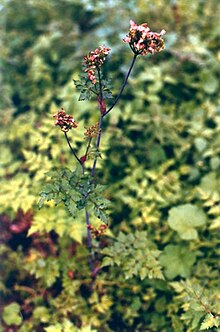Angelica sinensis
| Angelica sinensis | |
|---|---|

| |
| Scientific classification | |
| Kingdom: | Plantae |
| Clade: | Tracheophytes |
| Clade: | Angiosperms |
| Clade: | Eudicots |
| Clade: | Asterids |
| Order: | Apiales |
| Family: | Apiaceae |
| Genus: | Angelica |
| Species: | A. sinensis
|
| Binomial name | |
| Angelica sinensis | |
| Synonyms[2] | |
| |
Angelica sinensis,commonly known asdong quai(simplified Chinese:Đương quy;traditional Chinese:Đương quy;pinyin:dāngguī;Jyutping:dong1 gwai1;Pe̍h-ōe-jī:tong-kui) orfemaleginseng,is a herb belonging to the familyApiaceae,indigenous toChina.Angelica sinensisgrows in cool high altitude mountains in East Asia. The yellowish brown root of the plant is harvested in the fall and is a well-known Chinese medicine which has been used for thousands of years.[3]
Pharmacology
[edit]This sectionneeds morereliable medical referencesforverificationor relies too heavily onprimary sources.(May 2018) |  |
Growing environment
[edit]Angelica is hardy to 5 °C (41 °F)[4]and can be cultivated at elevations of 1,500 to 3,000 metres (5,000–10,000 ft). Seedlings need to be kept out of direct sunlight, but the mature plant can withstand it. Angelica requires deep moist fertile soil and is perennial if prevented from going to seed.[4]
Traditional Chinese medicine
[edit]The dried root ofA. sinensis– commonly known as Chinese angelica (Chinese:Đương quy;pinyin:dāngguī;Pe̍h-ōe-jī:tong-kui) – is widely used intraditional Chinese medicine,although there is insufficient evidence that it has any medicinal effect.[5]
Adverse effects
[edit]There is evidence thatA. sinensismay affect the muscles of theuterus.Women who are pregnant or planning on becoming pregnant should not useA. sinensis,because it may induce a miscarriage.[5]TakingA. sinensiscan cause skin to become extra sensitive to the sun, leading to a greater risk for skin cancer.[5]
Drug interactions
[edit]A. sinensismay increase the anticoagulant effects of the drugwarfarin(as it contains coumarins[6]) and consequently increase the risk of bleeding.[7]
Due to the antiplatelet andanticoagulanteffects ofA. sinensis,it should be taken with caution with herbs or supplements (such asginkgo,garlic,andginger) that may slow blood clotting to reduce the possible risk of bleeding and bruising.[5][8]
Chemistry
[edit]The plant's chemical constituents includephytosterols,polysaccharides,ligustilide,butylphthalide,cnidilide,isocnidilide,p-cymene,ferulate,andflavonoids.[9]
See also
[edit]- Angelica
- Chinese herbology
- Scutellaria baicalensis(Baikal skullcap)
- Eleutherococcus senticosusor Siberian ginseng
References
[edit]- ^"Angelica sinensis".Germplasm Resources Information Network.Agricultural Research Service,United States Department of Agriculture.Retrieved2012-06-30.
- ^"The Plant List: A Working List of All Plant Species".Retrieved7 July2015.
- ^"Dong quai".University of Maryland Medical Center.Archived fromthe originalon 2017-06-28.
- ^ab"Angelica sinensis".Angelica sinensis Dang Gui - Dong Quai - Chinese Angelica PFAF Plant Database.Retrieved20 February2021.
- ^abcd"Dong Quai".MedlinePlus, US National Library of Medicine. 2 April 2020.Retrieved8 December2020.
- ^Ying, Li; Si-Wang, Wang; Hong-Hai, Tu; Wei, Cao (2013)."Simultaneous quantification of six main active constituents in Chinese Angelica by high-performance liquid chromatography with photodiode array detector".Pharmacognosy Magazine.9(34): 114–119.doi:10.4103/0973-1296.111255.PMC3680850.PMID23772106.
- ^Page, Robert Lee; Lawrence, Julie D. (July 1999). "Potentiation of Warfarin byDong Quai".Pharmacotherapy.19(7): 870–876.doi:10.1592/phco.19.10.870.31558.PMID10417036.S2CID25661124.
- ^Tsai, Hsin-Hui; Lin, Hsiang-Wen; Lu, Ying-Hung; Chen, Yi-Ling; Mahady, Gail B.; Cox, Dermot (9 May 2013)."A Review of Potential Harmful Interactions between Anticoagulant/Antiplatelet Agents and Chinese Herbal Medicines".PLOS ONE.8(5): e64255.Bibcode:2013PLoSO...864255T.doi:10.1371/journal.pone.0064255.PMC3650066.PMID23671711.
- ^Zhao, Kui J.; Dong, Tina T. X.; Tu, Peng F.; Song, Zong H.; Lo, Chun K.; Tsim, Karl W. K. (April 2003). "Molecular Genetic and Chemical Assessment of RadixAngelica(Danggui) in China ".Journal of Agricultural and Food Chemistry.51(9): 2576–2583.doi:10.1021/jf026178h.PMID12696940.
External links
[edit]![]() Media related toAngelica sinensisat Wikimedia Commons
Media related toAngelica sinensisat Wikimedia Commons
- Angelica sinensisList of Chemicals (Dr. Duke's Databases)
- Ontario Ministry of Agriculture and Food
- Angelica Sinensis (Oliv.) Diels.Medicinal Plant Images Database (School of Chinese Medicine, Hong Kong Baptist University)(in Chinese)
- Đương quy, Dang Gui, Chinese AngelicaChinese Medicine Specimen Database (School of Chinese Medicine, Hong Kong Baptist University)(in Chinese)
